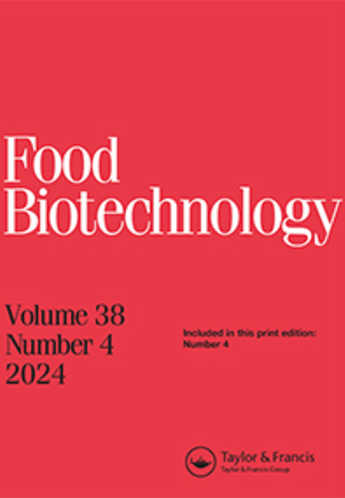从木薯发酵废水中分离的乳酸菌作为益生菌潜在候选者的鉴定和特性
IF 1.6
4区 农林科学
Q4 BIOTECHNOLOGY & APPLIED MICROBIOLOGY
引用次数: 0
摘要
摘要发酵木薯是由多种乳酸菌(LAB)在发酵过程中发挥主要作用,而副产物(出水)被丢弃的过程。本研究的目的是利用分子技术分离、鉴定和分析木薯发酵副产物/废水中潜在的益生菌。我们量化了乳酸菌的代谢产物,并测试了它们的抗菌性能。13株LAB均为革兰氏阳性,过氧化氢酶、氧化酶、吲哚酶和凝固酶均为阴性。13株分离菌中只有6株在低pH值1.5和0.3%的胆盐环境下存活。6株菌株对病原菌均表现出不同程度的抑菌活性,抑菌区范围为5.10 ~ 22.80 mm。分离得到的乳酸菌经鉴定为植物乳杆菌和发酵乳杆菌。结果表明,所选择的乳酸菌具有在酸性和富含胆汁的环境中生存的能力以及抗菌性能,具有作为益生菌的潜力。关键词:木薯发酵;潜在的益生菌;代谢物;乳酸二乙酰过氧化氢;补充材料本文的补充数据可在线访问https://doi.org/10.1080/08905436.2023.2276923Data可用性声明本研究使用的所有数据均在当前手稿中提供。APC由阿联酋阿兰的阿拉伯联合酋长国大学(UAEU)资助。本文章由计算机程序翻译,如有差异,请以英文原文为准。
Identification and Characterization of Lactic Acid Bacteria Isolated from Effluents Generated During Cassava Fermentation as Potential Candidates for Probiotics
ABSTRACTFermented cassava is obtained through fermentation process where the main role is played by various lactic acid bacteria (LAB), while the by-products (effluents) are discarded. The objective of this study was to isolate, identify and analyze potential probiotics in fermented cassava by-products/effluents using molecular techniques. We quantified the LAB’s metabolites and tested their antimicrobial properties. We isolated 13 LAB strains which are all Gram-positive, and catalase, oxidase, indole and coagulase negative. Only 6 out of 13 selected isolates survived the low pH of 1.5 and 0.3% bile salt. These 6 isolates showed different levels of antimicrobial activity against the tested pathogens with zones of inhibition ranging from 5.10 mm to 22.80 mm. The isolated LAB were identified as Lactiplantibacillus plantarum and Limosilactobacillus fermentum. The results indicated that the selected LAB strains have potential as probiotics due to their ability to survive in acidic and bile-rich environments as well as their antimicrobial properties. KEYWORDS: Cassava fermentationpotential probioticsmetaboliteslactic aciddiacetylhydrogen peroxide Disclosure statementNo potential conflict of interest was reported by the author(s).Supplementary materialSupplemental data for this article can be accessed online at https://doi.org/10.1080/08905436.2023.2276923Data availability statementAll data used for this study were presented in the current manuscript.Additional informationFundingThe APC was funded by United Arab Emirates University (UAEU), Alain, UAE.
求助全文
通过发布文献求助,成功后即可免费获取论文全文。
去求助
来源期刊

Food Biotechnology
工程技术-生物工程与应用微生物
CiteScore
3.80
自引率
0.00%
发文量
15
审稿时长
>12 weeks
期刊介绍:
Food Biotechnology is an international, peer-reviewed journal that is focused on current and emerging developments and applications of modern genetics, enzymatic, metabolic and systems-based biochemical processes in food and food-related biological systems. The goal is to help produce and improve foods, food ingredients, and functional foods at the processing stage and beyond agricultural production.
Other areas of strong interest are microbial and fermentation-based metabolic processing to improve foods, food microbiomes for health, metabolic basis for food ingredients with health benefits, molecular and metabolic approaches to functional foods, and biochemical processes for food waste remediation. In addition, articles addressing the topics of modern molecular, metabolic and biochemical approaches to improving food safety and quality are also published.
Researchers in agriculture, food science and nutrition, including food and biotechnology consultants around the world will benefit from the research published in Food Biotechnology. The published research and reviews can be utilized to further educational and research programs and may also be applied to food quality and value added processing challenges, which are continuously evolving and expanding based upon the peer reviewed research conducted and published in the journal.
 求助内容:
求助内容: 应助结果提醒方式:
应助结果提醒方式:


